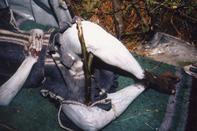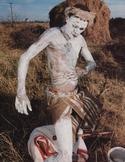
Variations in Male Initiation Practices
Ceremonies of South Africa
While the initiation period is characterised by a wealth of activities, youths generally languish in pain in the days immediately after they have been circumcised. Initiates often use cleft sticks to prevent external pressure from aggravating their wounds.
Xhosa initiates build temporary dwellings and make hats from ephemeral materials. Their transitional status is underlined by the wearing of blankets and other makeshift garments during this period in which they denounce contact with the outside world.
There are two seasons for Xhosa initiation rites (ulwaluko), one in the winter, the other in the summer. Known collectively as abakwethu, all initiates carry a short stick to which they attach a white cloth or piece of fur and must be at least 18 years old. Initiates throw this stick in the air after they have been circumcised.
It is not clear why initiates are covered in white clay after circumcision. According to some, the clay serves to keep them warm during the night and to protect them from the sun during the day. Others believe that it signifies the protection their ancestors afford them during this critical period of recovery.
Xhosa initiates are required to reapply white clay to their bodies at regular intervals. The master of the initiation lodge punishes those who fail to do so.
Many of the white and red blankets worn my Xhosa-speaking initiates are supplied by Aranda, a company specialising in the production of heritage blankets for different local markets, including the Basotho and the Ndebele.
While other local companies also produced red and white blankets for Xhosa-speaking initiates, Aranda claims that these ‘initiation and ceremonial’ blankets have become increasingly popular ‘among those wanting to create a unique look in their home’.
By
Professor Sandra Klopper












